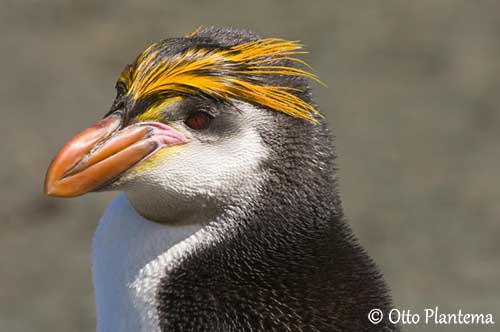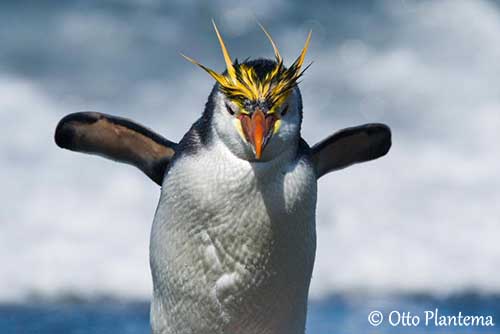
Fr: Gorfou de Schlegel
All: Haubenpinguin
Esp: Pingüino de Schlegel
Ital: Eudipte della Nuova Zelanda
Nd: Schlegels Pinguïn
Sd: Kungstofspingvin
Photographer:
Otto Plantema
Trips around the world
Text by Nicole Bouglouan
Sources:
HANDBOOK OF THE BIRDS OF THE WORLD vol 1 by Josep del Hoyo-Andrew Elliot-Jordi Sargatal - Lynx Edicions - ISBN: 8487334105
L’ENCYCLOPEDIE MONDIALE DES OISEAUX - Dr Christopher M. Perrins - BORDAS - ISBN: 2040185607
BirdLife International (BirdLife International)
Animal Diversity Web (University of Michigan Museum of Zoology)
PhotoVolcanica - Photography and Information by Dr Richard Roscoe
Royal penguin
Eudyptes schlegeli
Sphenisciforme Order – Spheniscidae Family
INTRODUCTION:
The Royal Penguin is very similar to the Macaroni Penguin (E. chrysolophus). Both species were formerly considered to be the same species. The Royal Penguin is the largest member of genus Eudyptes.
Both scientific and French names pay tribute to the German zoologist Hermann Schlegel (1804-1884).
Populations have increased through the 20th century, but this species has very restricted range on some islands, and is classified as Vulnerable.
DESCRIPTION OF THE BIRD:
Biometrics:
Length: 70-76 cm
Weight: 4500-5000 g
The adult has blue-black upperparts and flippers, and white underparts. The underside of flippers is white with black leading edge and tip. Unlike the Macaroni Penguin, it has white face, chin and throat.
On the head, the crest is orange-yellow and black, and formed by elongated feathers. The eye area is grey and the ear-coverts are white.
The red-orange bill is large and heavy, with pink gape and yellow wash below the lower mandible and on lores. The eyes are deep red. Legs and webbed feet are pale pink with black claws.

Both sexes are similar, with male larger than female.
The juvenile has shorter crest and greyer chin and throat.
The chick has dark greyish-brown first down, darker on head, and white below. The second down is blacker on the upperparts.
RANGE:
The Royal Penguin occurs on the sub-Antarctic islands, S to New Zealand, and breeds on Macquarie Island and adjacent islets.
HABITAT:
The Royal Penguin is marine, and pelagic outside the breeding season. On Macquarie Island, it breeds on beaches and grassy slopes, often between one and six kilometres from the coast. The habitat on this island includes rocks, tussock grass and small shrubs.
This species spends several months in coastal waters around the island.
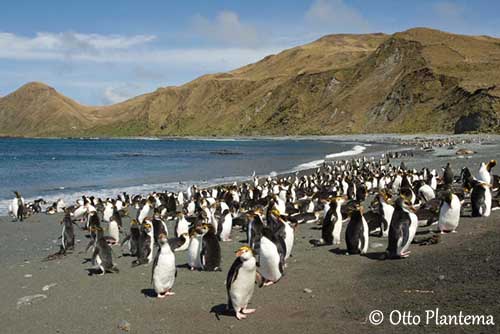
CALLS AND SONGS: SOUNDS BY XENO-CANTO
The Royal Penguin is highly social and noisy at colonies. They communicate through vocal and visual signals. We can hear contact calls, display calls between mates and threat calls during disputes.
The male produces some cough-like sounds during the “head-swinging” display, prior to copulation.
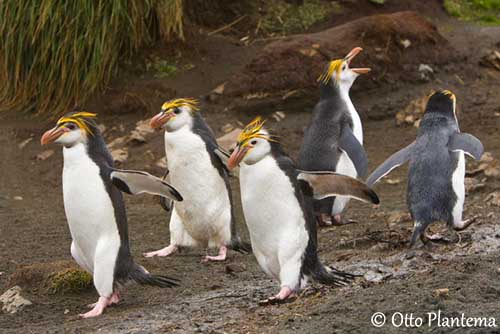
BEHAVIOUR IN THE WILD:
The Royal Penguin feeds primarily on krill and crustaceans of genus Euphausia. It also takes amphipods, cephalopods and some fish. It captures the preys by typical pursuit-diving.
It forages offshores in deep waters. It performs 10-11 dives per hour, and each dive lasts about one minute and half. It can dive down to 100 metres depth, but usually less than 60 metres.
The diet varies according to the season and also depends on the colony location.
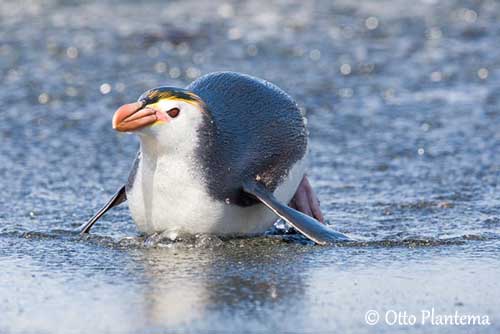
Like other Spheniscidae species, the Royal Penguin male returns to the colony in late September and establishes the nest-site. The female arrives in early October and courtship displays start at this period.
The commonest displays are “vertical-head-swinging” and “quivering”. During the first display, both birds face the nest with wide open bill, and produce quiet exhaling noises. While calling, the head is pointed skywards and swings from side to side. The “quivering” display involves bowing towards the nest with the bill trembling just above.
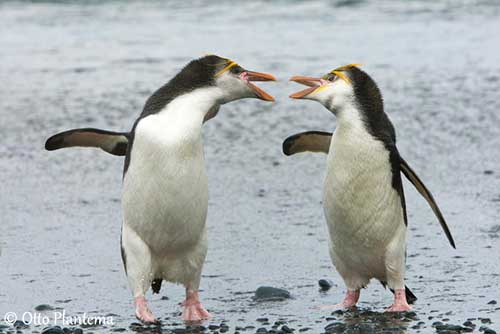
These displays are closely associated to nest and egg manipulation. Copulation follows this behaviour. Both mates often perform mutual preening to strengthen the pair-bonds.
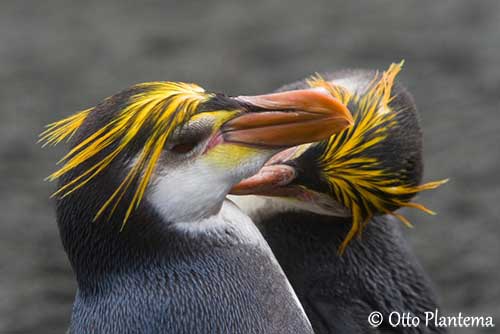
Some aggressive displays are common and occur both on land and in shallow water close to the beach. The birds face each other with open bill, and slightly lunge towards each other, while they produce a hissing noise. They may also attack rivals from behind while biting and gripping it at neck or back. Fighting rarely involves injuries.
The Royal Penguin has pre-moult period at sea during 35 days, and after completion of moult in March-April, it remains at sea from April to September, before the next breeding season.
This species is migratory and vagrant to SE Australia, Tasmania, New Zealand and rarely Antarctica.
The Royal Penguin may travel at speeds around 7km/hour when foraging. They use the typical “porpoising”, an undulating movement at regular intervals at water surface. They also perform “surface swimming” and “underwater-flying”.
On land, they walk with spread flippers, probably for body balance.
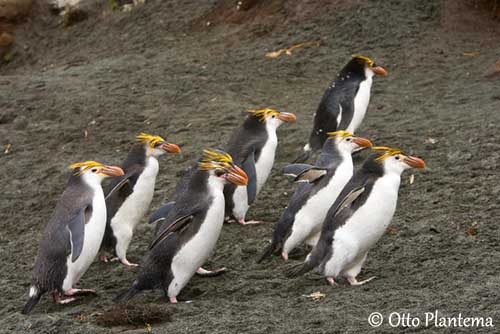
REPRODUCTION OF THIS SPECIES:
The laying takes place in October.
The Royal Penguin breeds colonially with thousands of birds. Colonies are usually located as far as two kilometres inland, and about 200 metres above the sea-level.
The nest is a shallow depression in stones or sand. It is made with small stones and often lined with grass or other available plant materials.
The female lays two eggs over four days. But the first egg is often ejected from the nest. The second egg is usually 60% larger than the first one. This is an extreme form of brood reduction.
The incubation lasts 32-37 days, shared by both parents with stints of 12-14 days. Each parent performs foraging trips while the other guards the nest. After hatching, the male tends the chicks during 3-4 weeks, while the female performs short foraging trips of 2-3 days. The chick joins a crèche at three weeks old, and fledges 65 days after hatching. Then, both parents go to sea for 35 days long foraging trip to gain weight after breeding.
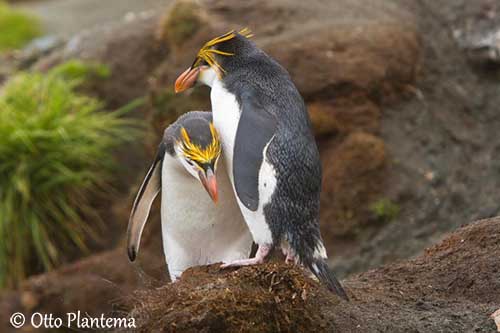
PROTECTION / THREATS / STATUS:
The Royal Penguin breeding success can be reduced by human disturbances and tourists. Pollution, especially ingested plastics, may kill the birds. But climate change affects the temperature of the sea surface and reduces the numbers of preys. The usual predators are skuas, giant petrels and seals.
The monitoring of breeding populations size is in progress. Introduced cats and rats are eradicated, but not completely. Tourism is managed to prevent disturbances.
However, the Royal Penguin is currently classified as Vulnerable.
